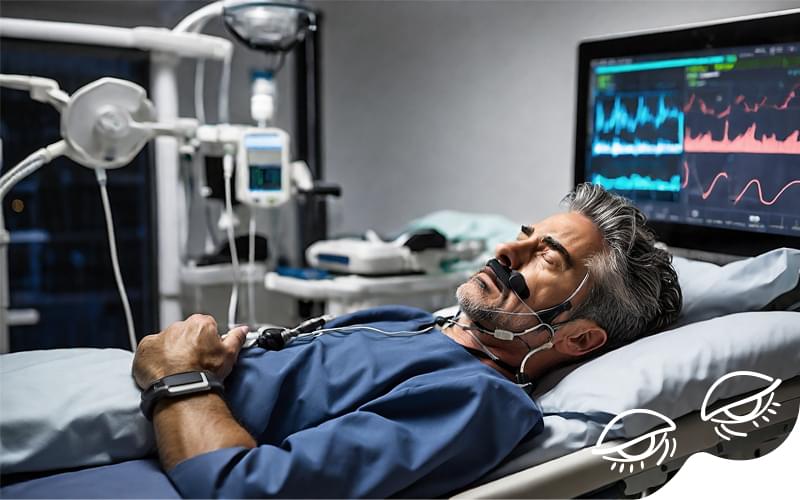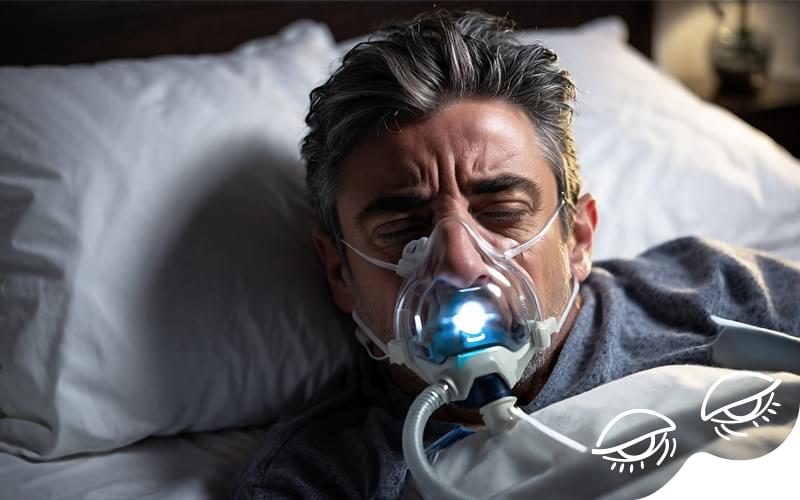
Sleep apnea remains an enigmatic disorder, often misunderstood and reduced to mere snoring. However, this nocturnal nuisance is a complex condition characterized by repeated pauses in breathing during sleep. These interruptions, known as apneas, occur due to the temporary blockage of the upper airway and can last anywhere from a few seconds to minutes, disrupting the natural sleep cycle. The prevalence of this disorder is alarmingly high, affecting millions globally, yet a significant number remain undiagnosed, primarily due to the subtlety of its symptoms.
The physiological implications of this condition extend far beyond daytime fatigue, encompassing a host of potential health risks. The cessation of breathing not only deprives the body of essential oxygen but also triggers stress responses that can exacerbate cardiovascular conditions. Scientific literature delineates a clear link between untreated sleep apnea and an increased risk of hypertension, heart disease, stroke, and type 2 diabetes, underscoring the critical need for awareness and early detection.
Table of key characteristics of Sleep Apnea:
| Feature | Description |
|---|---|
| Apneas | Pauses in breathing caused by airway blockage |
| Duration | Can last from a few seconds to minutes |
| Frequency | Can occur 5 to 30 times or more an hour |
| Risk Factors | Obesity, aging, family history, alcohol consumption, smoking |
| Potential Complications | Hypertension, heart disease, stroke, diabetes |
Understanding sleep apnea is imperative for both individuals and healthcare providers to mitigate its impact and improve health outcomes. The nuances of this condition demand a multifaceted approach that encompasses lifestyle interventions, medical equipment, and potentially surgical options to alleviate symptoms and restore quality sleep. By advancing our grasp of sleep apnea, we can peel back the layers of its complexity, transforming a night of restless sleep into one of tranquility and health restoration.

While snoring is frequently dismissed as a benign inconvenience, the repercussions of untreated sleep apnea extend far beyond nocturnal disturbances. This condition signifies a cessation of breathing during sleep, which can precipitate a cascade of adverse health outcomes. Cardiovascular complications, including hypertension, arrhythmias, and an increased likelihood of heart disease and stroke, are among the most severe consequences. The intermittent oxygen deprivation and fragmented sleep patterns can also exacerbate insulin resistance, paving the way for type 2 diabetes. Furthermore, the chronic sleep disruption inherent to sleep apnea undermines cognitive functions, contributing to difficulties with concentration, memory, and mood regulation, thereby diminishing overall quality of life.
The insidious nature of these symptoms often obfuscates the critical link between them and the underlying sleep disruption, leading many to overlook the urgency of seeking a medical evaluation. What is sleep disorders' role in this scenario? It's multifaceted; sleep apnea is a quintessential example that underscores the gravity of sleep disorders, demonstrating how they can clandestinely erode health, unbeknownst to the sufferer. Without proper diagnosis and intervention, individuals may inadvertently find themselves on a trajectory towards more severe health issues, emphasizing the importance of awareness and proactive health management.
The pathophysiology of sleep apnea involves not just an obstruction of the airway but also significant neurobiological repercussions that trigger a domino effect on various bodily systems. The repeated episodes of hypoxia (low blood oxygen levels) and reoxygenation create oxidative stress and systemic inflammation, fostering the development and progression of the aforementioned conditions. It is this complex interplay between disrupted sleep architecture and systemic physiological distress that magnifies the risk of long-term complications, highlighting the imperative of recognizing and addressing sleep apnea not merely as a sleep disturbance but as a critical factor in holistic health preservation.
Delving into the etiology of sleep apnea, it becomes evident that the disorder stems from an intricate web of causes and risk factors, each contributing to the complexity of what is sleep disorders. Obesity emerges as a predominant catalyst, owing to the excess fatty tissues that can obstruct the upper airway during sleep. Additionally, anatomical variances such as a narrow airway, enlarged tonsils, or adenoids significantly elevate the risk, especially in children. Beyond physical predispositions, lifestyle factors like smoking and alcohol consumption exacerbate the likelihood of developing sleep apnea by increasing inflammation and relaxing the muscles in the throat, further impeding the airflow during sleep.
Genetics also play a non-negligible role in predisposition to sleep apnea, with a family history of the disorder indicating a higher susceptibility. Endocrine disorders, including hypothyroidism and polycystic ovary syndrome (PCOS), alongside respiratory conditions such as asthma and chronic obstructive pulmonary disease (COPD), have been identified as comorbid factors that can amplify the risk. Age, too, is a critical determinant, with the incidence of sleep apnea escalating in middle-aged and older adults, though it’s crucial to acknowledge that sleep apnea does not discriminate by age and can affect individuals of all ages.
Navigating through the labyrinth of risk factors underscores the importance of early detection and intervention. Highlighting the essence of understanding these risk factors is pivotal, as it paves the way not only for heightened awareness but also for proactive measures in mitigating the risk of developing sleep apnea. The complexity of its causes serves as a reminder of the multifaceted nature of sleep disorders, necessitating a comprehensive approach in both research and treatment to unlock the door to restorative sleep and overall health improvement.
Sleep apnea encompasses more than a single condition; it is an umbrella term for several disorders that disrupt normal breathing patterns during sleep. The most well-known type is Obstructive Sleep Apnea (OSA), characterized by physical blockages of the airway, such as the relaxation of throat muscles leading to narrowed airways. Central Sleep Apnea (CSA), less common but equally concerning, arises not from physical obstructions but from the brain's failure to send proper signals to the muscles controlling breathing. This disconnection leads to specific pauses in breathing, manifesting a different facet of what sleep disorders can entail.
Understanding these distinctions is crucial, as each type demands unique treatment approaches. For instance, while CPAP (Continuous Positive Airway Pressure) machines are widely recommended for OSA, addressing CSA might involve managing underlying health conditions or employing adaptive servo-ventilation devices, underscoring the need for accurate diagnosis and tailored treatments. The complexity reflects the multifaceted nature of sleep apnea, transcending simplistic categorizations and requiring a nuanced understanding of its manifestations.
Furthermore, a rare variant, Complex Sleep Apnea, occurs when an individual presents both OSA and CSA symptoms. This convergence challenges conventional treatment strategies and necessitates an integrated approach, combining various therapies to address the fluctuating dynamics of airway obstruction and neurological control of breathing. The intricate interplay of multiple factors in complex sleep apnea underscores the necessity for a comprehensive evaluation to craft an effective treatment plan.
In delving into the scientific intricacies that define the types of sleep apnea, it becomes evident that addressing these disorders goes beyond managing nighttime disruptions. It's a critical component of safeguarding overall health, averting potential complications, and enhancing quality of life. The journey from recognition to management of sleep apnea is steeped in a deep understanding of its diverse manifestations, reinforcing the need for specialized care tailored to each unique case.

Diagnosing sleep apnea transcends mere observation of nocturnal disturbances; it requires a comprehensive clinical evaluation often initiated due to the suspicion of sleep disorders. The journey to diagnosis commences with a detailed medical history and physical examination, where healthcare providers delve into the symptoms and the severity of potential sleep disruptions. Particular attention is paid to the presence of risk factors such as obesity, neck circumference, and family history of sleep apnea.
Following the preliminary assessment, the definitive diagnosis of sleep apnea typically involves polysomnography, an overnight sleep study meticulously designed to monitor various physiological parameters during sleep. This study is conducted in a specialized sleep clinic, where professionals equipped with advanced technology observe and record brain waves, oxygen levels in the blood, heart rate, breathing, and eye and leg movements. The data collected provides a comprehensive overview of the patient’s sleep architecture, pinpointing interruptions in breathing and the extent of apnea episodes.
| Parameter | Description |
|---|---|
| Brain Waves | Monitored to assess sleep stages and quality. |
| Oxygen Levels | Measured to determine the drop in oxygen associated with apnea episodes. |
| Heart Rate | Observed for fluctuations that may indicate cardiovascular stress. |
| Breathing Patterns | Evaluated to identify apnea or hypopnea events. |
| Eye and Leg Movements | Tracked to provide insights into sleep phase and potential periodic limb movement disorders. |
Furthermore, for individuals who cannot undergo polysomnography at a clinic, home sleep apnea tests (HSATs) offer a viable alternative. These tests focus primarily on breathing and oxygen levels, providing essential but somewhat limited data compared to in-clinic polysomnography. Regardless of the setting, the objective remains to gather empirical evidence, quantifying the severity of sleep apnea and laying the groundwork for an accurate diagnosis. This scientific approach underscores the intricacies of diagnosing sleep apnea, affirming that it is indeed a condition anchored in precise, measurable physiological disruptions, beyond the rudimentary symptom of snoring.

Embarking on the journey to mitigate the impacts of sleep apnea, it is paramount to comprehend the spectrum of treatment modalities that promise a more restful slumber and an enhanced quality of life. Initially, lifestyle modifications, such as weight management, cessation of smoking, and adopting a side-sleeping position, are recommended to alleviate mild instances of sleep apnea. These preemptive measures target the root causes of airflow obstruction during sleep. In more pronounced cases, Continuous Positive Airway Pressure (CPAP) therapy emerges as the cornerstone treatment. This involves the patient wearing a mask over the nose and/or mouth during sleep, which is connected to a machine that gently blows air into the throat. The pressure from the air keeps the airway open, thereby preventing apnea episodes and snoring.
For individuals seeking alternatives to CPAP or with specific anatomical considerations, dental appliances have shown efficacy in repositioning the lower jaw and tongue to keep the airway open. These devices, often custom-fitted by dental specialists experienced in sleep disorders, offer a portable and less intrusive option. Meanwhile, advancing technologies and research have paved the way for more innovative approaches, including nerve stimulators that maintain airway patency by monitoring and modulating the breathing pattern during sleep.
In cases where other treatments have not yielded desired outcomes or when anatomical anomalies are identified as contributing factors, surgical interventions may be considered. Surgical options range from uvulopalatopharyngoplasty (removing soft tissue in the back of the throat) to more complex procedures like maxillomandibular advancement, which repositions the jaw to enlarge the airway space. Each surgical route is meticulously tailored to the patient's specific condition, taking into account the severity of the sleep apnea and the anatomical structure of the throat and jaw.

270 Pine Mountain Rd Ste 5 Hudson NC 28638
(828) 757-8282